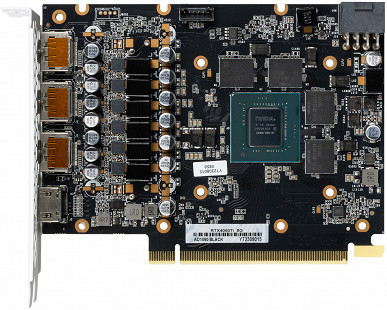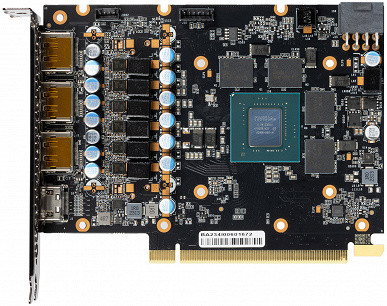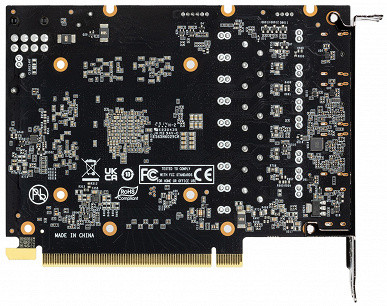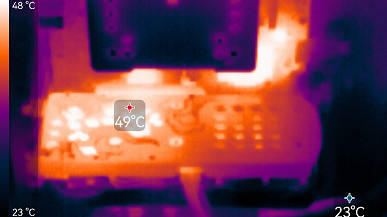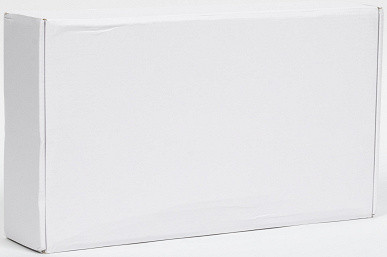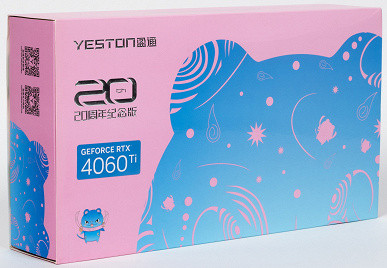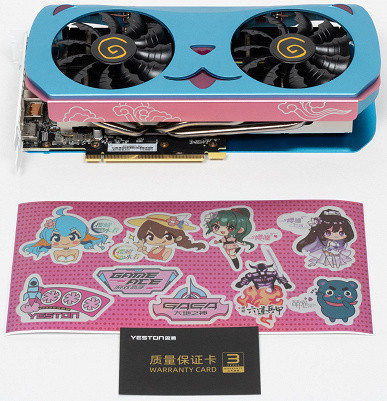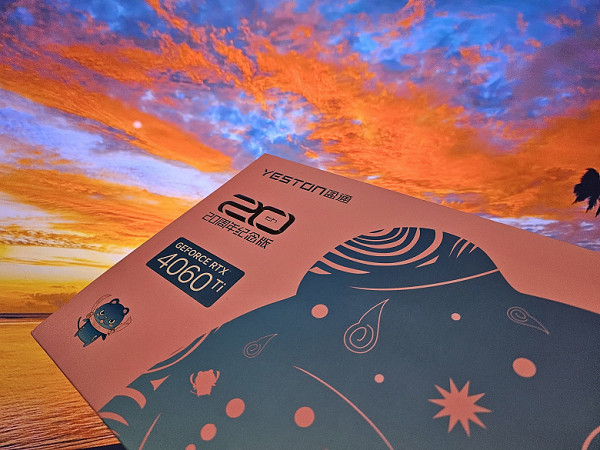
Briefly about the main thing
When the GeForce RTX 4060 Ti was released, most reviewers criticized it as a failure due to the small performance increase compared to its predecessor GeForce RTX 3060 Ti — only 7%-9% (in cases of games without DLSS 3, which are more than 90% on current), and the initial price from Nvidia was too high.
However, over time, with the advent of a large number of video cards and as GeForce RTX 3060 Ti stocks depleted, the situation has changed significantly. Currently, the GeForce RTX 4060 Ti represents some of the best value options, especially considering its 8GB of local memory. The version with 16 GB of memory is not in wide demand due to inflated prices and the lack of practical need for such an amount of memory on a relatively powerful but budget video card: for 1080p resolution, more than 8 GB of memory is considered excessive.
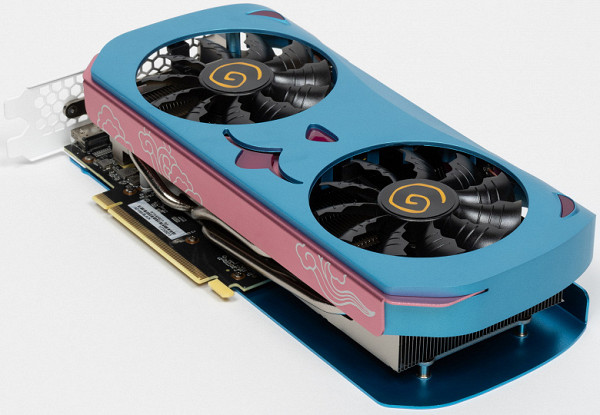
Today we are reviewing products from Shenzhen Yingjiaxun/Yeston Industrial (later Shenzhen Yeston Digital Technology). Please be reminded that the company, founded in 2000 in Shenzhen, is an IT enterprise specializing in the research, development, production and marketing of computer accessories. Yeston has independent brands such as «Yingtong/Yeston» and «Game Master» and offers products including graphics cards, motherboards and power supplies.
The term «Yeston» translates to «to conquer people and gain access to the world.» Since its establishment, the company has earned recognition in the local market, established an extensive support network, and won loyal customers in various regions of China. The brand does not have its own production facilities and uses third-party factories, and also purchases ready-made cards or boards from OEM manufacturers. For example, most powerful Yeston video cards are based on printed circuit boards from Palit, which is widely known outside its borders.
Yeston currently has offices and service centers in various cities in China. If Yeston products were previously presented exclusively on the domestic market, then thanks to marketplaces such as Ozon and Aliexpress, they are also available to international consumers.
The popularity of Yeston products in China is partly due to the design of a number of series, inspired by popular animated series in China. The company offers original solutions that are created not only by circuit engineers, but also by artist-designers. In China, “cute” fictional characters from cartoons and comics, such as cats and dogs, are especially popular. The video card we are reviewing today is distinguished by its design, inspired by the appearance of such a “cute” cat.
Before presenting detailed tests, we will provide brief information about the performance of the family to which the accelerator under study belongs, as well as its competitors. Our assessment will be subjective and presented on a scale of seven gradations.
Games without ray tracing (classic rasterization):
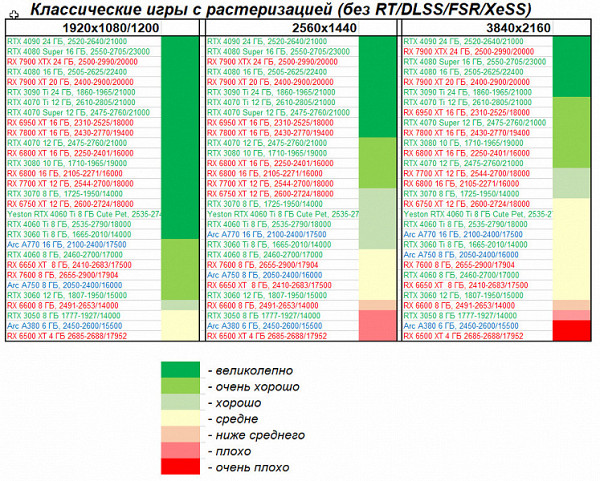
In terms of performance, the GeForce RTX 4060 Ti occupies an intermediate position between the GeForce RTX 3060 Ti and the GeForce RTX 3070. This video card provides high performance in most games at maximum settings with ray tracing and upscaling technologies disabled at resolutions up to 2.5K. However, to maintain a comfortable gaming environment in some graphically complex games, you will have to either reduce the graphics settings or resolution. Among the closest competitors are AMD Radeon RX 6700/6750 XT and Intel Arc A770.
As for the Yeston video card, it fully corresponds to the reference analogue.
Games using ray tracing and DLSS/FSR/XeSS:

Many games have already been released that support Nvidia DLSS technologies, as well as AMD FSR and Intel XeSS, and the number is constantly growing. Therefore, in general, the performance drop from enabling ray tracing is no longer so critical, especially with support for the above-mentioned scaling technologies. It's important to note that the Radeon RX 6000 family of graphics cards experience a larger FPS drop from ray tracing enabled, even with FSR enabled, making the GeForce RTX 4060 Ti a more attractive choice for games that support these technologies. In addition, all GeForce RTX 40 support DLSS 3 technology, which is becoming increasingly popular. With DLSS 3, ray tracing can be enabled without significant performance loss. However, it should be noted that a fully comfortable gaming experience on the GeForce RTX 4060 Ti is achieved primarily in Full HD resolution (1080p), while for 4K resolution (2160p) these cards may be less suitable due to limited memory.
Card characteristics
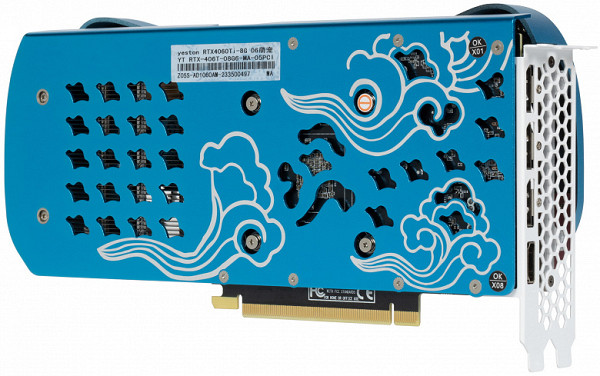

Information about the manufacturer: The Yeston company was founded in 2000 in the People's Republic of China. Headquarters in Shenzhen, full name Shenzhen Yeston Digital Technology Co. (trademarks Yeston/Yingtong, Game Master). From 2003 to the present day, Yeston has been developing and promoting models of video cards (retail market), motherboards (OEM sales), power supplies (OEM sales). The company employs about 200 engineers, designers, architects, marketers, product managers, etc. The company orders its products from third-party factories (primarily from Palit (Tongde) facilities), without having its own production facilities.
| Yeston GeForce RTX 4060 Ti Cute Pet 8GD6 8GB 128-bit GDDR6X | ||
|---|---|---|
| Parameter | Meaning | Nominal value (reference) |
| GPU | GeForce RTX 4060 Ti (AD106) | |
| Interface | PCI Express x8 4.0 | |
| GPU operating frequency (ROPs), MHz | 2535(Boost)—2745(Max) | 2535(Boost)—2790(Max) |
| Memory operating frequency (physical (effective)), MHz | 2250 (18000) | 2250 (18000) |
| Memory bus width, bits | 128 | |
| Number of computational units in the GPU | 34 | |
| Number of operations (ALU/CUDA) in block | 128 | |
| Total number of ALU/CUDA blocks | 4352 | |
| Number of texturing units (BLF/TLF/ANIS) | 136 | |
| Number of rasterization units (ROP) | 48 | |
| Number of Ray Tracing blocks | 34 | |
| Number of tensor blocks | 136 | |
| Dimensions, mm | 250×110×55 | 250×110×40 |
| Number of slots in the system unit occupied by a video card | 3 | 2 |
| PCB color | black | black |
| Peak power consumption in 3D, W | 144 | 160 |
| Power consumption in 2D mode, W | thirty | thirty |
| Energy consumption in sleep mode, W | eleven | eleven |
| Noise level in 3D (maximum load), dBA | 32.7 | 35.0 |
| Noise level in 2D (video viewing), dBA | 18.0 | 18.0 |
| Noise level in 2D (idle), dBA | 18.0 | 18.0 |
| Video outputs | 1×HDMI 2.1, 3×DisplayPort 1.4a | 1×HDMI 2.1, 3×DisplayPort 1.4a |
| Multiprocessing support | No | |
| Maximum number of receivers/monitors for simultaneous image output | 4 | 4 |
| Power: 8-pin connectors | 1 | 0 |
| Power: 6-pin connectors | 0 | 0 |
| Power: 16-pin connectors | 0 | 1 |
| Weight of the card with delivery set (gross), kg | 1.4 | 1.3 |
| Card weight (net), kg | 0.8 | 0.9 |
| Maximum resolution/frequency, DisplayPort | 3840×2160@144 Hz, 7680×4320@60 Hz | |
| Maximum resolution/frequency, HDMI | 3840×2160@144 Hz, 7680×4320@60 Hz |
Memory
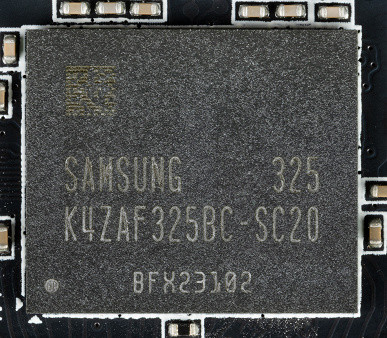
The card has 8 GB of GDDR6 SDRAM memory located in 4 16 Gbit chips on the front side of the PCB. Samsung memory chips (K4ZAF325BC-SC20) are designed for a nominal operating frequency of 2500 (20000) MHz.
Card features and comparison with Palit GeForce RTX 4060 Ti Dual (8 GB)
We are comparing this video card with a similar model from Palit in order to confirm the practical identity of the printed circuit boards (PCBs): there is a possibility that Yeston orders (or purchases ready-made) cards from Palit.
The graphics card core is labeled AD106-350, and its release date is the 29th week of 2023.
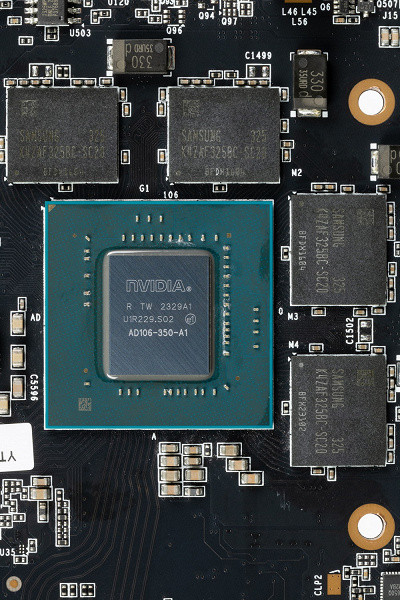
The total number of power phases on the Yeston card is 7 (6+1).

In the diagram, the core power circuit is highlighted in green, and the memory power circuit is highlighted in red. All PWM controllers are located on the reverse side of the PCB.
The 6 phases of core power are controlled by the uP9512R controller from uPI Semiconductor. This controller is designed for a maximum of 12 phases.

The power supply for the memory chips is controlled by the 7212 controller (On Semiconductor), which has OEM markings.
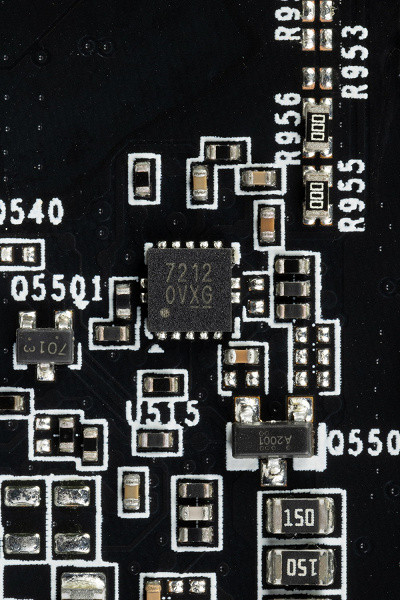
The core power converter uses DrMOS transistor assemblies — in this case MP87990 (Monolith Power Systems), each of which is rated at a maximum of 70 A.
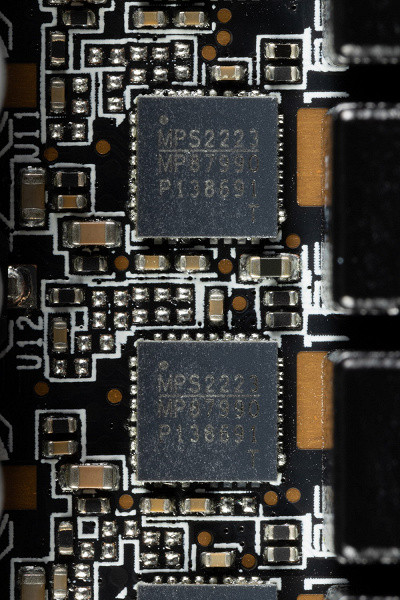
In the single-phase power supply circuit of the memory chips, field-effect transistors SM4377/4503 (Sinopower), also designed for a maximum current of 50 A, are used.

On the front side of the board there is a uS5650Q (uPI Semi) controller, which is responsible for monitoring the card (monitoring voltages and temperatures).
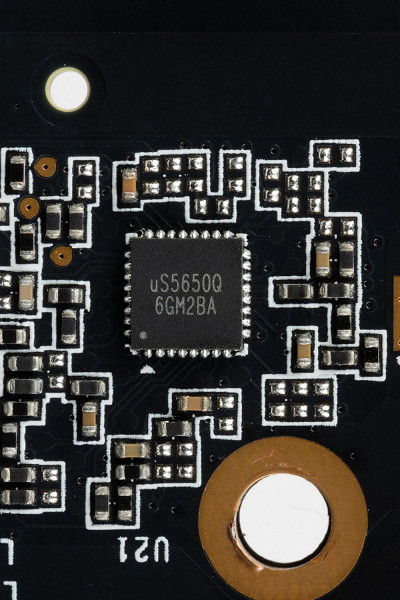
The GPU itself performs the function of controlling the backlight on the card, providing only one lighting scenario.
Standard memory frequencies and Boost values for core frequencies correspond to reference values. The maximum core frequency is slightly below the reference level, and as a result we get gaming performance almost comparable to the reference card.
The card's power consumption in tests reaches 133 W, with short-term peaks of up to 144 W. The power consumption limit of this card cannot be increased. However, an experiment was conducted on manual overclocking, in which it was possible to reach maximum frequencies of 2865/19900 MHz, which led to an increase in gaming performance by an average of almost 2% compared to the reference values. At the same time, the card's energy consumption increased to 142 W.
The Yeston card receives power via an 8-pin PCIe 2.0 connector.

Let's note the standard dimensions of the card: length 25 cm, height 11 cm and thickness 5.5 cm. As a result, the video card occupies 3 slots in the system unit.

SLI multi-graphics configuration technologies are not supported in the GeForce RTX 4060 Ti.
The video card is equipped with a standard set of video outputs: three DP 1.4a ports and one HDMI 2.1.
Yeston does not provide its own software to control the operation of the card.
Heating and cooling

The basis of the cooling system is a segmented nickel plated radiator with three heat pipes that distribute thermal energy along the radiator fins. The tubes are connected to an extensive heat sink that fits tightly to the core.
Memory chips are cooled using the same soleplate and thermal pads. To cool the GPU power converters, a separate heat sink is provided, also located on the same radiator. The transistors of the memory power circuit remain without additional cooling.

The backplate serves solely as PCB protection and also serves as an important design element.
Above the radiator there is a casing equipped with two 90 mm diameter fans with grooved blades.
The fans stop working at low load on the video card if the GPU temperature drops below 50 degrees. When the computer starts, the fans operate, but after loading the video driver, the operating temperature is checked and they are automatically turned off.
Temperature monitoring
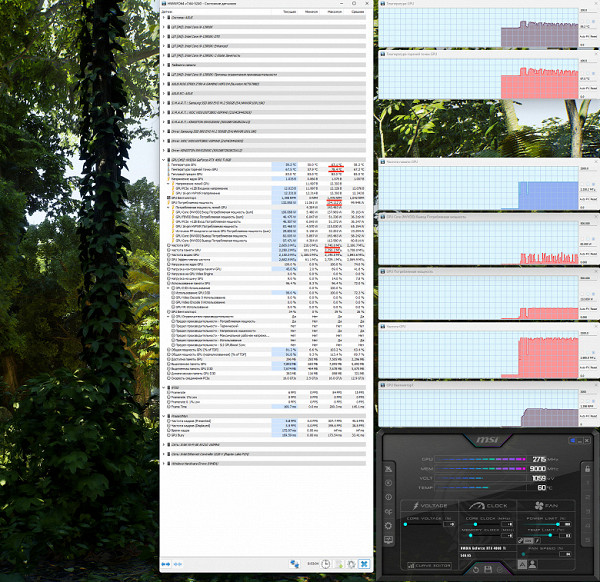
After a two-hour test, the maximum core temperature did not exceed 67 °C, which is considered an excellent indicator. The power consumption of the video card reached 134 W (with peak values of 144 W). The GPU hotspot temperature reached 78°C.
Maximum heating is near the GPU and power converters.
9-minute heating process, 50 times faster:
During manual overclocking (described above), the heating and noise parameters remained virtually unchanged.

Noise
Noise measurements assume that the room is soundproofed and echo suppressed and that reverberation is minimized. The system unit used to measure video card noise does not contain fans and is not a source of mechanical noise. The background noise level is 18 dBA — this is the noise level in the room and the reading of your own sound level meter. Measurements are taken at a distance of 50 cm from the video card, at the level of its cooling system.
Measurement modes include:
- Idle mode in 2D: the system is loaded with an Internet browser with the site iXBT.com, a Microsoft Word window and a number of Internet communicators.
- 2D movie mode: uses SmoothVideo Project (SVP) with hardware decoding and insertion of intermediate frames.
- 3D mode with maximum load on the accelerator: FurMark test.
The noise level rating is as follows:
- less than 20 dBA: relatively silent
- 20 to 25 dBA: very quiet
- from 25 to 30 dBA: quiet
- from 30 to 35 dBA: clearly audible
- from 35 to 40 dBA: loud, but tolerable
- above 40 dBA: very loud
In idle mode in 2D, the temperature did not exceed 41 °C, the fans did not work, and the noise level was consistent with the background level — 18 dBA.
When watching a movie with hardware decoding, the situation did not change.
In maximum load mode in 3D, the temperature reached 67/78 °C (core/hot spot). At the same time, the fans spun up to 1476 rpm, the noise level increased to 32.7 dBA, which is clearly audible.
The noise spectrogram shows that there were no annoying peaks during the study.

Backlight
The card's fans are illuminated, as well as acrylic inserts on the CO casing, indicating the «mouth», «nose» and «ears» of the cat.
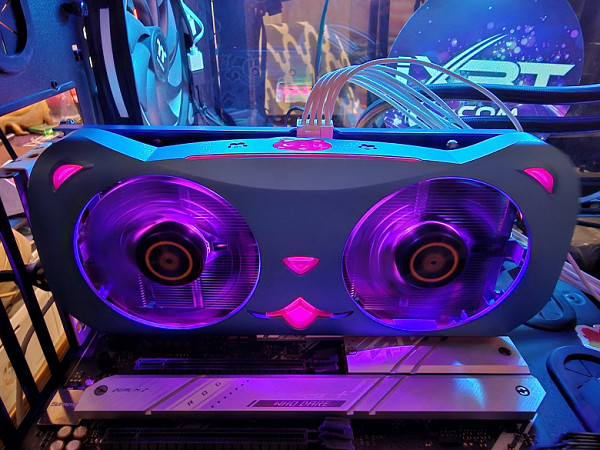
The backlight is unadjustable and cannot be switched off; all LEDs glow a single lilac color and periodically turn on/off, simulating breathing.
In general, the backlight is interesting, but the non-switchable backlight can quickly get boring.
Delivery and packaging
The delivery set includes only a set of stickers from the cartoons beloved by the Chinese. A beautiful box in honor of the 20th anniversary of the launch of Yeston video cards is packed in an additional white cardboard box
conclusions
The Yeston GeForce RTX 4060 Ti Cute Pet 8GD6 (8 GB) video card is a unique external design of a mid-budget video accelerator. Its sophisticated design makes it attractive, especially for those who plan to use it in DLSS games (especially DLSS 3). The device has moderate power consumption (up to 145 W), low noise level of the cooling system and standard dimensions (25 × 11 × 5.5 cm, 3 slots). The set of video outputs includes 3 DP ports and 1 HDMI port. The card is equipped with a regular 8-pin power connector. The main highlight of this model is the design of a cute animal face, supported by the backlight, but it should be noted that the backlight cannot be turned off.
The manufacturer provides a 3-year warranty on this card (a warranty card is included in the package). However, warranty service will require the card to be shipped back to China, which may incur additional shipping costs.

It is noted once again that at the time of preparation of the review, the Yeston GeForce RTX 4060 Ti video card was available only on the Ozone and Aliexpress platforms. It is important to note that its price was lower than the minimum price of similar models presented on Yandex.Market.
We remind you that the GeForce RTX 4060 Ti is ideal for gaming at 1080p resolution at maximum graphics settings, including ray tracing, using DLSS/FSR/XeSS technologies. The card also performs well at 2.5K resolution without ray tracing. There is support for the HDMI 2.1 standard, which provides 4K image output at 120 FPS or 8K using a single cable. Other important features include hardware decoding of AV1 video data, RTX IO technology for fast data transfer and decompression, and Reflex latency-reducing technology, especially useful for esports athletes. Also worth highlighting is support for the new version of DLSS 3.0, which provides improved resolution scaling and frame rate doubling using tween technology. This is achieved through the Optical Flow Accelerator, enhanced by the Ada Lovelace architecture.

